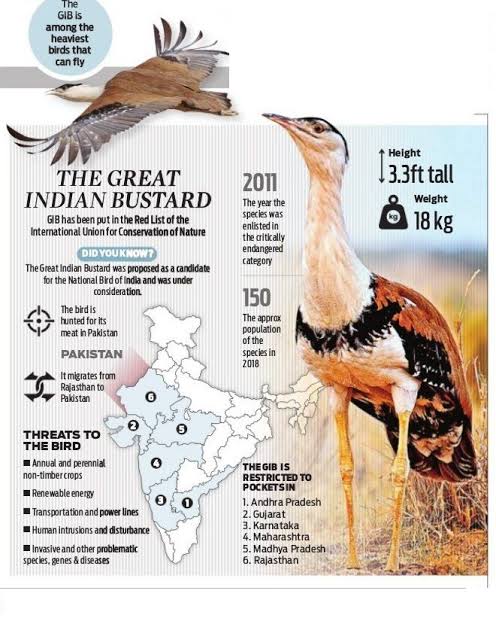Description

Copyright infringement is not intended
Context: The Supreme Court of India sought an update from the committee formed for making power lines underground in Rajasthan and Gujarat ordered a year ago.
More about news:
- The habitat of the state bird of Rajasthan — the Great Indian Bustard (GIB) or Godavan — is under threat due to the zigzag web of high-tension power lines through the sacred groves of Jaisalmer.
- The sacred groves of the Degrai Oran and adjoining area are few of the last remaining habitats of the GIB.
- Wind farms and solar parks in the area have encroached upon the grasslands and the high-tension power lines criss-crossing through several points in the region pose a threat of electrocution of the big birds.
- SC had ordered the power companies in the states of Rajasthan and Gujarat to make the high-tension power lines underground so that the large birds do not get caught in the web.
- Around 122 of the total 150 GIBs found in the country were in Jaisalmer district of Rajasthan, according to a 2018 GIB count. The rest were scattered in Gujarat, Maharashtra and Karnataka.
Great Indian Bustard (GIB):
- GIB is one of the most critically threatened speciesin India, with less than 150 birds left in the wild.
- GIBs are one of the heaviest flying birdsin India.
- Experts say only two districts in Rajasthan — Jaisalmer and Barmer— have a breeding GIB population in the wild.
- The bird can also be found in very small numbers in Gujarat, Madhya Pradesh, Karnataka, Maharashtra and Andhra Pradesh.
Steps taken by the Government for protection of Great Indian Bustards in the country:
- A site for establishment of a Conservation Breeding Centre for the Great Indian Bustard has been identified at Kota District, Rajasthan, under the project ‘Habitat Improvement and Conservation Breeding of Great Indian Bustard-an integrated approach’.
- A satellite conservation breeding facilitywith incubator, hatcher, chick rearing and housing for captive birds has been set up at Sam, Jaisalmer, Rajasthan.
- The Great Indian Bustard is listed in Schedule-I of the Wild Life (Protection) Act, 1972,thereby, according it highest degree of legal protection from hunting.
- Important habitats of Great Indian Bustards are designated as National Parks/Sanctuaries for their better protection.
- The species has been identified for conservation efforts under the component ‘Species Recovery Programme’ of the Centrally Sponsored Scheme (CSS)-Development of Wildlife Habitat.
- The Ministry with financial support from National Authority for Compensatory Afforestation Funds has sanctioned an outlay of Rs. 33.85 croresfor the duration of five years for the programme ‘Habitat Improvement and Conservation Breeding of Great Indian Bustard-an integrated approach’ to build up captive population of Great Indian Bustard.
- Ministry has also constituted a Task Force for suggesting Eco- friendly measures to mitigate impacts of power transmission lines and other power transmission infrastructureson wildlife including the Great Indian Bustard.
- The Great Indian Bustard has been included in the Appendix I of Convention on Migratory Species (CMS)of the basis of proposal submitted by India. It was also the mascot of the prestigious 13th CMS Conference of Parties held in Gandhinagar giving wider publicity for the conservation of the species.
https://www.downtoearth.org.in/news/wildlife-biodiversity/supreme-court-seeks-update-on-power-cables-at-great-indian-bustard-s-habitat-82233














